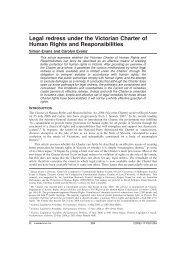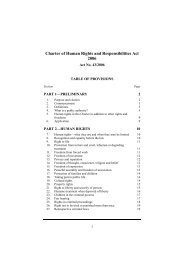The Impact of the Corporate Form on Corporate Liability for ...
The Impact of the Corporate Form on Corporate Liability for ...
The Impact of the Corporate Form on Corporate Liability for ...
Create successful ePaper yourself
Turn your PDF publications into a flip-book with our unique Google optimized e-Paper software.
In my view something more than <str<strong>on</strong>g>the</str<strong>on</strong>g> indirect legal and commercial capacity <str<strong>on</strong>g>of</str<strong>on</strong>g> <str<strong>on</strong>g>the</str<strong>on</strong>g><br />
parent companies to c<strong>on</strong>trol and direct <str<strong>on</strong>g>the</str<strong>on</strong>g> subsidiaries, plus <str<strong>on</strong>g>the</str<strong>on</strong>g> parent’s<br />
involvement in implementing <str<strong>on</strong>g>the</str<strong>on</strong>g> cartel arrangement, is required to lift <str<strong>on</strong>g>the</str<strong>on</strong>g> corporate veil<br />
between <str<strong>on</strong>g>the</str<strong>on</strong>g> subsidiaries and <str<strong>on</strong>g>the</str<strong>on</strong>g>ir parents or to find that each <str<strong>on</strong>g>of</str<strong>on</strong>g> <str<strong>on</strong>g>the</str<strong>on</strong>g> subsidiaries is carrying<br />
<strong>on</strong> its business as <str<strong>on</strong>g>the</str<strong>on</strong>g> agent <strong>for</strong> <str<strong>on</strong>g>the</str<strong>on</strong>g> parent. That is particularly so where it is c<strong>on</strong>tended (as<br />
it is in <str<strong>on</strong>g>the</str<strong>on</strong>g> present case) that <str<strong>on</strong>g>the</str<strong>on</strong>g> parent, ra<str<strong>on</strong>g>the</str<strong>on</strong>g>r than <str<strong>on</strong>g>the</str<strong>on</strong>g> subsidiary, is carrying <strong>on</strong> business in<br />
Australia or, put ano<str<strong>on</strong>g>the</str<strong>on</strong>g>r way, <str<strong>on</strong>g>the</str<strong>on</strong>g> subsidiary is engaging in all <str<strong>on</strong>g>of</str<strong>on</strong>g> its commercial activities <strong>on</strong><br />
behalf <str<strong>on</strong>g>of</str<strong>on</strong>g>, and <str<strong>on</strong>g>the</str<strong>on</strong>g>re<strong>for</strong>e as agent <strong>for</strong>, <str<strong>on</strong>g>the</str<strong>on</strong>g> parent. [emphasis added]<br />
131. Merkel J's approach suggests that direct involvement <str<strong>on</strong>g>of</str<strong>on</strong>g> <str<strong>on</strong>g>the</str<strong>on</strong>g> parent company is necessary<br />
to lift <str<strong>on</strong>g>the</str<strong>on</strong>g> corporate veil in an agency-type situati<strong>on</strong>.<br />
9.3 Piercing <str<strong>on</strong>g>the</str<strong>on</strong>g> veil - fraud<br />
132. It is unc<strong>on</strong>troversial that where a corporate structure is used to perpetrate a fraud, <str<strong>on</strong>g>the</str<strong>on</strong>g><br />
courts will look behind <str<strong>on</strong>g>the</str<strong>on</strong>g> corporati<strong>on</strong> to <str<strong>on</strong>g>the</str<strong>on</strong>g> perpetrators <str<strong>on</strong>g>of</str<strong>on</strong>g> <str<strong>on</strong>g>the</str<strong>on</strong>g> fraud. Australian and<br />
British Courts will disregard <str<strong>on</strong>g>the</str<strong>on</strong>g> existence <str<strong>on</strong>g>of</str<strong>on</strong>g> a corporate structure and attribute liability to<br />
those behind <str<strong>on</strong>g>the</str<strong>on</strong>g> company where <str<strong>on</strong>g>the</str<strong>on</strong>g>y use <str<strong>on</strong>g>the</str<strong>on</strong>g> structure as a vehicle <strong>for</strong> committing fraud. 98<br />
9.4 Piercing <str<strong>on</strong>g>the</str<strong>on</strong>g> veil – sham, façade or avoidance <str<strong>on</strong>g>of</str<strong>on</strong>g> an existing legal duty<br />
133. Ano<str<strong>on</strong>g>the</str<strong>on</strong>g>r well established principle in corporati<strong>on</strong>s law is that a company structure cannot<br />
be used to avoid an existing legal duty or obligati<strong>on</strong>. If a court finds that pers<strong>on</strong>s, including<br />
a company, who are under an existing legal obligati<strong>on</strong> (such as in c<strong>on</strong>tract, liability <strong>for</strong><br />
debts, or vicarious liability in tort) <strong>for</strong>med a company <strong>for</strong> <str<strong>on</strong>g>the</str<strong>on</strong>g> sole or dominant purpose <str<strong>on</strong>g>of</str<strong>on</strong>g><br />
breaching <str<strong>on</strong>g>the</str<strong>on</strong>g>ir obligati<strong>on</strong> or avoiding <str<strong>on</strong>g>the</str<strong>on</strong>g> obligati<strong>on</strong>, <str<strong>on</strong>g>the</str<strong>on</strong>g> court may find that <str<strong>on</strong>g>the</str<strong>on</strong>g> acti<strong>on</strong>s <str<strong>on</strong>g>of</str<strong>on</strong>g><br />
<str<strong>on</strong>g>the</str<strong>on</strong>g> company that breach <str<strong>on</strong>g>the</str<strong>on</strong>g> obligati<strong>on</strong>s are in fact <str<strong>on</strong>g>the</str<strong>on</strong>g> acti<strong>on</strong>s <str<strong>on</strong>g>of</str<strong>on</strong>g> <str<strong>on</strong>g>the</str<strong>on</strong>g> pers<strong>on</strong> under <str<strong>on</strong>g>the</str<strong>on</strong>g><br />
obligati<strong>on</strong>, namely, <str<strong>on</strong>g>the</str<strong>on</strong>g> company that instituted <str<strong>on</strong>g>the</str<strong>on</strong>g> sham or façade corporati<strong>on</strong>.<br />
134. For example, in J<strong>on</strong>es v Lipman [1962] 1 WLR 832, Mr Lipman agreed to sell land to<br />
Mr J<strong>on</strong>es, but instead, prior to <str<strong>on</strong>g>the</str<strong>on</strong>g> settlement <str<strong>on</strong>g>of</str<strong>on</strong>g> <str<strong>on</strong>g>the</str<strong>on</strong>g> c<strong>on</strong>tract, acquired a company and sold<br />
<str<strong>on</strong>g>the</str<strong>on</strong>g> land to <str<strong>on</strong>g>the</str<strong>on</strong>g> company. Mr Lipman was <str<strong>on</strong>g>the</str<strong>on</strong>g> director and <strong>on</strong>ly shareholder in <str<strong>on</strong>g>the</str<strong>on</strong>g> company.<br />
He admitted to <str<strong>on</strong>g>the</str<strong>on</strong>g> court that he had sold <str<strong>on</strong>g>the</str<strong>on</strong>g> land to <str<strong>on</strong>g>the</str<strong>on</strong>g> company to avoid a ruling <str<strong>on</strong>g>of</str<strong>on</strong>g><br />
specific per<strong>for</strong>mance <str<strong>on</strong>g>of</str<strong>on</strong>g> <str<strong>on</strong>g>the</str<strong>on</strong>g> c<strong>on</strong>tract <str<strong>on</strong>g>of</str<strong>on</strong>g> sale with Mr J<strong>on</strong>es. 99<br />
135. <str<strong>on</strong>g>The</str<strong>on</strong>g> court held <strong>for</strong> Mr J<strong>on</strong>es, and ordered specific per<strong>for</strong>mance <str<strong>on</strong>g>of</str<strong>on</strong>g> <str<strong>on</strong>g>the</str<strong>on</strong>g> c<strong>on</strong>tract <str<strong>on</strong>g>of</str<strong>on</strong>g> sale.<br />
Russell J stated that <str<strong>on</strong>g>the</str<strong>on</strong>g> company was a ‘device and a sham’ behind which Mr Lipman<br />
sought to avoid his obligati<strong>on</strong>s to Mr J<strong>on</strong>es and <str<strong>on</strong>g>the</str<strong>on</strong>g> equitable jurisdicti<strong>on</strong> <str<strong>on</strong>g>of</str<strong>on</strong>g> <str<strong>on</strong>g>the</str<strong>on</strong>g> court. In <str<strong>on</strong>g>the</str<strong>on</strong>g><br />
circumstances, it was appropriate to lift <str<strong>on</strong>g>the</str<strong>on</strong>g> corporate veil. 100<br />
136. Australian courts, however, have still exercised some cauti<strong>on</strong> about lifting <str<strong>on</strong>g>the</str<strong>on</strong>g> corporate veil<br />
in cases where it is alleged that an individual is using <str<strong>on</strong>g>the</str<strong>on</strong>g> corporate structure to avoid<br />
pers<strong>on</strong>al liability. In Pi<strong>on</strong>eer C<strong>on</strong>crete Services Ltd v Yelnah Pty Ltd Justice Young stated<br />
98<br />
99<br />
100<br />
<str<strong>on</strong>g>The</str<strong>on</strong>g> Laws <str<strong>on</strong>g>of</str<strong>on</strong>g> Australia at [4.1.16]; Re Darby; Ex parte Brougham [1911] 1 KB 95 is <str<strong>on</strong>g>the</str<strong>on</strong>g> leading case in this area.<br />
<str<strong>on</strong>g>The</str<strong>on</strong>g> case involved two bankrupts who registered a company which <str<strong>on</strong>g>the</str<strong>on</strong>g>y used as a fr<strong>on</strong>t <strong>for</strong> making m<strong>on</strong>ey under<br />
<str<strong>on</strong>g>the</str<strong>on</strong>g> guise <str<strong>on</strong>g>of</str<strong>on</strong>g> an investment 'opportunity.' <str<strong>on</strong>g>The</str<strong>on</strong>g> court allowed a claim against <strong>on</strong>e <str<strong>on</strong>g>of</str<strong>on</strong>g> <str<strong>on</strong>g>the</str<strong>on</strong>g> bankrupts to access <str<strong>on</strong>g>the</str<strong>on</strong>g><br />
secret pr<str<strong>on</strong>g>of</str<strong>on</strong>g>its as <str<strong>on</strong>g>the</str<strong>on</strong>g> entity was found to be a fraudulent venture.<br />
See also <str<strong>on</strong>g>the</str<strong>on</strong>g> UK case <str<strong>on</strong>g>of</str<strong>on</strong>g> Gil<strong>for</strong>d Motor Company Ltd v Horne [1933] Ch 935.<br />
See also Gil<strong>for</strong>d Motor Co Ltd v Horne [1933] 1 Ch 935<br />
9.2.2007 Page 25



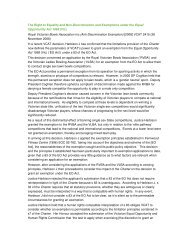
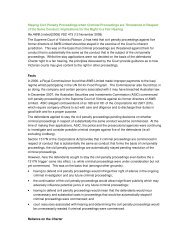
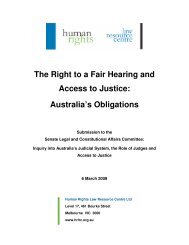
![Maslov v Austria [2008] ECHR - Human Rights Law Centre](https://img.yumpu.com/38882316/1/190x245/maslov-v-austria-2008-echr-human-rights-law-centre.jpg?quality=85)
![Kortel v Mirik [2008].pdf - Human Rights Law Centre](https://img.yumpu.com/38882257/1/190x245/kortel-v-mirik-2008pdf-human-rights-law-centre.jpg?quality=85)

